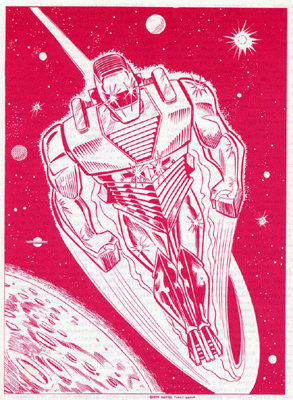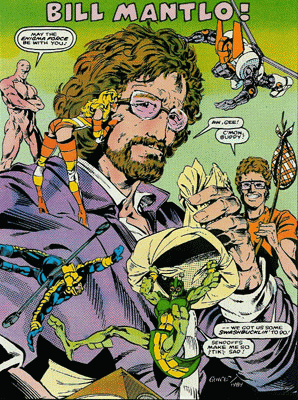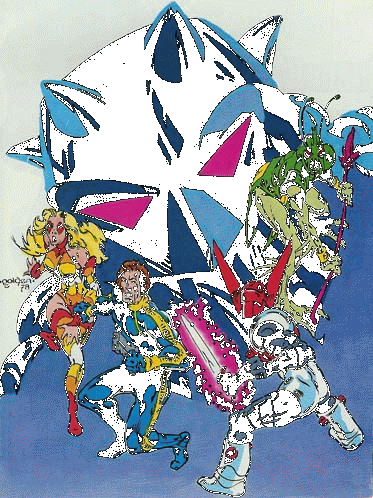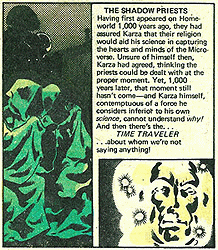
Interview
with Bill Mantlo Bem #24 July 1979
Part 2
(back to part 1)
|
|
BEM: In an interview in Heroines Showcase #16, Chris Claremont mentioned that both you and he were "pulling off the same stuff", the Len Wein giant issue, when he wrote #94 and you wrote the fill-in, and your issue could have gone in and worked then, but in the intervening two years the characters had developed completely different voices, so he re-wrote it, so in the end there was hardly a line in there that wasn't your original script. So you shouldn't get the blame if the characterization is below par! Bill: Chris is absolutely correct. I agree with him. My fill-in issue for X-Men was plotted for a specific time- within a few months of the day it was plotted- and by the time it finally ran, the characters had changed and developed beyond it. I had no objections to Chris' re-write (since I was paid for my original script anyway) and would have aided in the re-writing if necessary or had he asked me to. I think Chris' X-Men is one of the finest comics produced by Marvel. For a while it seemed to be the only title deserving the term "original". I think times have changed since then, though. While X-Men is still original and enormously popular, and that some of the fine work is being produced by David Michelinie on the Avengers and by Roger McKenzie on Daredevil is beginning to truly create a new "Marvel Renaissance". Sure, you've heard about Marvel moving again before, but this time under Jim shooter's editorial control, it really seems to be happening. And wait until you see our newest character: ROM! |
 |
 image by Butch Guice from Micronauts #58 |
|
BEM: How did the books regular writer feel about someone else coming in to do a fill-in writing "his" character? Bill: The regular writers, if they were professionals, never objected to fill-ins, realizing that they were late and the book had to come out. The prima donnas always objected. I think its safe to say that most of the prima donnas no longer work at Marvel, and that is partially attributed to Jim shooter. BEM: Marvels changed since you began to write fill-ins, I imagine. Bill: Marv Wolfman was the first editor who seemed to have the most respect for my work, and the most compassion for what it was like to be a "fill-in king". But Marv, like Len and Archie and Roy, got swamped by idiotic business concerns with Cadence and, after a time, couldn't oversee the books. Marv's a writer, not a businessman. He couldn't do both and still get quality form his writers. So he quit. Gerry Conway was hired and he quit. Archie Goodwin was hired and he quit. Jim shooter was hired… …and changes began to be made. Jim, in close consultation with Stan, divided up the editorial load among associate editors while he, as editor-in-chief, was responsible for the whole line. This meant he could devote his time and considerable energies to the business and conceptual end, while his associates (Roger Stern, Al Milgrom, Mark Gruenwald, Ralph Macchio, Jo Duffy and Rick Marschall) devoted themselves to the direction of specific books and to general proofreading. Jim is totally professional. He assigns writers to books because he feels they belong there, not out of favoritism or nepotism or fannishness. A writer always knows where he stands under Jim (literally under, Jim being well over six feet tall), which is a refreshing change from the constant uncertainty and insecurity, which plagued Marvel for years. |
|
Jim is also the finest plotter (Marv Wolfman's a close second!) I've ever met. He knows what you're doing with your characters, and can quickly pin point what you should be doing with them. He'll override your directions, but he'll tell you why he's doing it, and his reasoning is never capricious. I've gained tremendous respect for him over the past year and a half. He's made writing for Marvel fun again. BEM: I tend to think of your writing on Marvel Team-Up as your "big break", Bill. Was it an assignment you wanted? Did you enjoy doing it? And how sad were you to leave? Bill: Marvel Team-Up, as I said, was enjoyable but limited. You couldn't develop the character of Spidey or his guest star, so you tend to do hero meets hero/they fight/reconcile/and go after villain together stories. Real primal stuff. I tried to change that by (a) getting Spidey's alter ego, Peter Parker, in it more often; (b) extending guest starts for more than one issue-I was the first to do this with MTU- (c) introduce my own supporting cast-i.e., lady detective Jean DeWolff; and (d) have Spidey time and space hopping just to get him out of New York, where he would have collided with himself due to his appearances in Peter Parker and Amazing. But needless to say, while readers like these excursions, extended appearances, etc., some editors didn't, wanting to return MTU to it's second class status. I think I had run my course on MTU, and didn't mind giving it up. But I think I changed everyone's concept of MTU, and I think that Chris Claremont has continued my directions, adding a few embellishments of his own. Like crashing jet liners every other month… |
|
|
BEM: Before we go onto the Micronauts, we ought to talk a little more on your work on 'Sons of the Tiger' and 'White Tiger'. Did you find more freedom in the black & white books both for you and the artist? And how did you come to create the first Puerto Rican super hero? Bill: There was more freedom in the black & white books at the time I did Sons of the Tiger primarily because no one cared. George Perez and I pretty much did as we pleased, and George began perfecting some of that wonderful multi-panel experimental storytelling of his free from editorial oversight, or concern. George of course is Hispanic, Puerto Rican to be exact, and had an intimate knowledge of the gritty city/slum that is the South Bronx. So I said, "Hey George-let's do a character that reflects that grim reality!" I described the costume as Spidey's without and details (remember, in black & white comics color is nonexistent) and George went hoe and designed it. The conception was mine, but nobody brings a character to life like George Perez, so we share the credit of having created Hector Ayala/the White Tiger.But again, though reader interest was massive, no one in editorial at the time cared to see Hector in his own mag. Why? Perhaps they feel the sales potential of the character is poor, perhaps they're afraid of Marvel's predominantly whit middle class ignoring a Hispanic super hero. |
|
Luke Cage doesn't sell all that well, but as I've pointed out, the White Tiger isn't Luke Cage. WT is popular as a co-star in Peter Parker, but I'll be phasing him out of there to concentrate more on Spidey. So he will vanish, maybe forever, into Marvel limbo. I'd like to showcase him somewhere, as I did Jack of Hearts (another character no one at the bullpen cared for, though fans loved him) but it doesn't seem likely. Another problem is that fans, while vocal, make up a minority of Marvel's buying audience. It's the kids who pick up a mag at the newsstand month after month because something about the mag catches their eye who keep Marvel's main titles alive. I don't know if Jack of Hearts or White Tiger have that potential. I don't plan on doing anything with Jack in the near future, and I don't know if anyone else does either. I'd like to start a new super group with him in it, but I don't know how likely that is. As I see it, it would feature Jack, the White Tiger, Hawkeye, the Black Widow and another female, perhaps a new character. BEM: I find Jack most exhilarating, intriguing hero. If he is given his own book, would you automatically be the writer? How would you feel if someone else was given the scripting assignment? Bill: If Jack was given his own book, based on the sales from his appearance in Marvel Premier, I would say that, knowing Jim shooter, I would be given the mag to write. Whether I stay on it would depend on the quality I bring to it, and to some extent, the sales figures. But I'm realistic and professional enough to realize that, under present circumstances in the industry, I don't own any character or concept I create for a Marvel mag-Marvel owns it. So if Marvel chose to replace me on my own character, which I don't think Stan or Jim would do without overwhelming reasons, I would have little to complain about, having entered into the arrangement with my eyes open. I'd like to see this system change. I'd like to see that artists and writers given a percentage of their characters, of any merchandising rights sold, of reprint residuals for foreign publication (we only get domestic reprint residuals now) but all that's what I'd like to see, not what is. But I assume your question is a veiled reference to my taking over Howard The Duck after Steve Gerber left. Everyone assumes, partially because of Steve's own statements, that Howard was Steve's Duck. Steve created Howard (with Val Mayerik and Frank Brunner-and a roomful of people one night at a party as I hear it) but he also signed the Marvel checks, which clearly state that any rights to any characters or concepts belong to Marvel. It's one thing to challenge the statement before you sign, but quite another to challenge it retroactively, a few years after Marvel's taken the risk of publishing 31 issues of the Duck. I agree with Steve's position re writer's ownership, but that's simply not reality at the present moment. So if Marvel did take Jack or Micronauts away from me, I'd have to choose between quitting or accepting it. |
|
BEM: Right, let's move onto the Micronauts. How did Marvel come to be doing the series? Bill: My son got a few of the Mego Micronaut toys for Christmas in 1977. I thought they had great potential and wrote a proposal, detailing the directions I foresaw for these tiny aliens from a subatomic Microverse, and handed it to Jim shooter. Jim apparently liked the idea, because he got in touch with Stan and they got in touch with Mego. The idea went through, and Jim gave me the go-ahead to develop the characters, to write a treatment. I did, then we searched for an artist. Jack Kirby was mentioned, but he was ending out his contract with Marvel, so no one knew whether he'd re-new it-subsequently, he didn't. Then George Perez was contacted. George accepted, but it quickly became obvious he couldn't handle the workload. Jim called me up-I was getting desperate to begin-and asked me if I'd seen the work of Michael Golden over at National. I said no, I never read DC comics, but Jim suggested I pick up Mr. Miracle! I did, and fell in love with Michael's artwork immediately. Jim got in touch with Michael, who asked, " What? A comic book about little toys?" but who agreed to get together with us to discuss it. Mike evidentially like the direction I laid out, because he accepted, and he, I, and editor Bob Hall began plotting the first twelve issues (yes, we plotted the entire epic, from Karza's triumph to his downfall) at the start, so the Karza epic would be finite. We weren't sure, because of contractual arrangements with Mego, whether we could feature Marvel characters in the mag, so we avoided it-later it turned out that we could feature Marvel characters in the Micronauts, but that we couldn't feature the Micronauts in any other Marvel mag. I added Marionette and Bug to Mego's line up, made Acroyear a good guy - in opposition to Acroyear II, his brother Prince Shaitan - and Michael designed the Endeavor. |
 |
We got to work, and produced the most convoluted first issue in the history of comics! Jim and Stan were appalled! "What did you do? We can't understand this?!" they yelled. "And if we can't understand it, how do you expect the kid's to understand it?!" they continued. Michael and I got extremely depressed, and began to try and simplify the storyline without sacrificing any of the sci-fi elements inherent in the book; no easy task when your dealing with immortality, body banks, sub-molecular solar systems, warp drives and the like. But we persevered, and the result is a mag that seems to be incredibly popular, on par with X-Men fanwise, although we still haven't received any sales figures on #1 (it takes 12 weeks). So at the time of this interview, we don't know if we have a hit or a flop on our hands, or what. I hope it's a hit, and I understand that Micronauts has begun to appear in Star Wars Weekly with #50 over your way. I just wish Michael and I got residuals from that. |
|
 |
Bill: As far as artists, Jim and Al Milgrom are very attentive to my pleas. They listen to my requests, and tell me if it can't be done, and tell me who is available. I've been very fortunate in working with Michael-a great artist and fantastic storyteller. However, Michaels taking a 5-issue leave of absence after Micronauts #12, and Howard Chaykin-another favorite of mine for years-will do those 5 issues, with Al Milgrom himself tentatively scheduled to ink them. Micronauts #13 & 14 have been turned in by Howie already, and they're great, dealing with Bug on his homeworld of Kalikak. Very Gil Kane-ish, very science fictiony. |
 |
|
BEM: How do you see the personalities of the main characters in Micronauts? Bill: The personalities of the characters partially arose from their visual appearance as toys. Not knowing Mego's conception of their own toys at the time, I decided that Space Glider looked like the commander of a starship, that Biotron looked like an obsolete, semi-human roboid, that Microtron looked like he was a funny little guy, that Acroyear looked tough, and Acroyear II and Baron Karza looked evil. Time Traveler looked ethereal. Force /commander suggested not so much the ultimate force for good, but an emissary for good. There were no female toys-I'm told the Japanese female toy characters are considered sexually gross to American toy buyers, firing projectiles from their breasts and pubic areas, etc-so I created Marionette, the Princess Mari. Mego's Galactic Warrior I made insect like, and gave the name Bug, but Mego's disowned Bug and now he's a Marvel owned character. Slug, Captain Universe, Jasmine, Cilicia and other characters who will be making appearances sooner or later are all my, or my and Michael's creations. |
 |
BEM: Does the name "Arcturus Rann" have any connection with that classic SF series of the 60's, in which Adam Strange adventured on a planet called Rann? Bill: I made Commander Rann/Space Glider commander of the Endeavor, borrowing his name from the planet that Adam Strange found himself zeta-beamed to years ago, as homage to the artists and writers of that classic strip. I'm big into paying my respects to the creators of the classic comic book heroes I grew up with. BEM: The whole series seems an intriguing mixture of a number of plots and concepts that have never been done in full justice in comics before- Kirby's 'Fourth World' for instance. I was going to mention 'Star Wars', but that in itself is more of a skillful mixture of concepts than a wholly original brew… Bill: Kirby's 'Fourth World' was incredibly inspirational, thought, I always felt, erratic and confusing, spread over five or more books. I try to accomplish what Jack attempted in one book. It ain't easy. 'Star Wars' too, had some effect, but not much. I saw the movie well after I conceived the Micronauts, and was surprised at how closely the two meshed. But as you say, 'Star Wars' itself was a derivative of both standard sci-fi stories and much of Stan Lee's work, which I consider a direct precursor of my own writing. So Micronauts is a mixture of the new and the old, of comics and sci-fi, of comics and history (you'll see a lot of sidewise references to Herodotus in the mag) and of comics and religion. I guess its closest parallels are again Kirby's 'Fourth World' and the Thor comic stuff he and Stan did back in the mid-sixties. Yeah, a lot of Thor. |
|
BEM: How long do you see yourself writing Micronauts? If you had to relinquish one of your assignments, would it be this one, or Micronauts, or what? Bill: I'd like to write Micronauts until it becomes boring. I'm a great believer in writing 100 issues of a mag. I've never done it, but I think it's incredible, for instance that Stan did it in the Fantastic four, Thor, Spider-Man, and I'd like to try it. I like the idea of crafting an epic. I don't know if all the characters will remain constant- after all, by Micronauts #14 I've got two more members, both female added to the team and it's beginning to get unwieldy- but change, too, is part of the epic structure. As far as relinquishing assignments, I rarely have to give up anything because I'm so fast. Usually I'm deprived of a mag through cancellation or trade-off. I guess I'd let Tarzan go first, although I find it supremely easy to write, because I don't really think you can top Burroughs, or that you can continue adapting him, or that you can write a character who's been around for 60 or 70 years without repeating what's already been done. Also, although I love Sal Buscema's layouts on the book, I've hated practically every inker. I don't think the book looks very good, and I'm very concerned with the ultimate quality of the books I write. Howard I wouldn't give up for the world. BEM: Talking of Howard the Duck, are you finding it hard or easy to step in the wake of Steve Gerber? |
 |
|
Bill: I find Howard easy to write, but most of all I find it fun to write. The duck and I share similar egocentricities (don't ask me what they are) I find that my sense of the absurd isn't very different- although more linear- than Steve Gerber's. At first I worried about following Steve, stepping into his shoes, etc, and hate mail from fans who didn't even read my first issue (#30) didn't help. Nor did the preceding two fill-in issues. But after Howard #30 hit the stands and mail started pouring in, I know my fears were groundless. The praise was overwhelming. The criticisms were right on. Only a few nut letters like, "I'm never going to read Howard again because Marvel screwed Steve Gerber…!" Hey, I didn't screw Steve Gerber (I don't swing that way!) I just wrote what I was told to write, and let Marvel and Steve have it out by themselves. I do resent peoples refusing to even look at my Howard or judging me by some incomplete or faulty understanding they've developed about that it means to be a professional comic book writer. But then I cooled out and decided it was their loss. Hell, I know I'm doing a good job on the duck, both on the color comic and the new black & white magazine, so why should I worry about some nutso fan who's gonna denounce my work without even reading it? If they don't like it after reading it, that's another story, and I'm willing to chance their disapproval. BEM: Thank you for your time and trouble, Bill, I've found what you told us very interesting. There's a lot more we could cover- but let's leave things here for the time being. |
click here to see the first part of the interview Part
1
Thanks goes out to Geoff Gayan for supplying the scans of the magazine